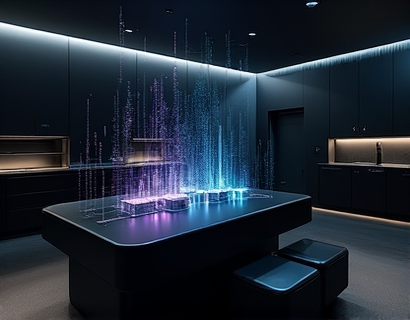Unlock Real-Time Engagement: Harnessing AI Avatar Technology for Dynamic Live Communication
In the rapidly evolving landscape of digital communication, businesses and content creators are constantly seeking innovative ways to captivate and engage their audiences. One of the most promising advancements in this field is the integration of AI avatar technology, which brings dynamic, lifelike characters to live presentations and virtual events. This cutting-edge solution not only enhances the visual appeal of digital interactions but also significantly boosts audience engagement and retention. By leveraging advanced AI avatars, organizations can deliver memorable and impactful messages in real-time, revolutionizing the way we communicate online.
The concept of using AI avatars in live communication is rooted in the fusion of artificial intelligence and computer graphics. These digital characters are designed to mimic human behavior and expressions, creating a more natural and relatable interaction experience. Unlike static images or pre-recorded videos, AI avatars can respond to audience inputs, adapt to different scenarios, and maintain a level of interactivity that keeps viewers engaged throughout the presentation or event. This real-time adaptability is crucial for maintaining audience interest and ensuring that the message is effectively conveyed.
Enhancing Live Presentations with AI Avatars
For businesses and content creators, incorporating AI avatars into live presentations offers numerous benefits. One of the primary advantages is the ability to create a more immersive and engaging experience for the audience. Traditional presentations often suffer from monotony, with speakers delivering scripts in a flat, unengaging manner. AI avatars, on the other hand, can add a layer of personality and charisma, making the presentation more enjoyable and memorable. The avatar can use gestures, facial expressions, and even tone of voice to convey emotions and emphasize key points, thereby enhancing the overall impact of the message.
Moreover, AI avatars can help overcome language barriers and cultural differences. By customizing the avatar's appearance and speech patterns, content creators can tailor the communication to specific audiences, ensuring that the message resonates across diverse groups. This flexibility is particularly valuable for global companies and international events, where a one-size-fits-all approach may fall short. The ability to adapt and personalize the communication experience can lead to higher levels of audience engagement and better retention of information.
Real-Time Interaction and Audience Engagement
One of the most significant advantages of AI avatars in live communication is their capacity for real-time interaction. Unlike pre-recorded content, AI avatars can respond to questions, comments, and feedback from the audience instantly. This immediate interaction not only makes the presentation more dynamic but also fosters a sense of community and involvement among viewers. Audience members feel more connected to the content and the presenter, leading to a more engaging and memorable experience.
Real-time interaction is particularly beneficial for Q&A sessions, where the AI avatar can process and respond to questions on the fly. This capability ensures that no query goes unanswered, and the audience receives timely and relevant information. Additionally, the avatar can use non-verbal cues such as nodding or tilting the head to indicate understanding or to prompt further clarification, enhancing the natural flow of the conversation. This level of interactivity is difficult to achieve with traditional presentation methods and can significantly boost audience satisfaction and trust in the brand.
Creating Lifelike and Persuasive Avatars
The success of AI avatars in live communication hinges on their ability to appear lifelike and persuasive. Advanced AI algorithms and machine learning techniques are employed to create avatars that exhibit human-like behavior and expressions. Facial recognition and synthesis technologies ensure that the avatar's facial movements are natural and synchronized with the spoken words. Similarly, advanced motion capture and animation techniques are used to replicate realistic body language and gestures.
To further enhance the realism, AI avatars can be equipped with voice synthesis capabilities that mimic human speech patterns, including intonation, pace, and emotional tone. This multi-modal approach—combining visual and auditory cues—creates a more convincing and engaging presence. The result is an avatar that not only looks lifelike but also communicates in a way that feels natural and authentic, making it easier for the audience to connect with the content and the message being conveyed.
Applications Across Various Industries
The applications of AI avatar technology in live communication are vast and varied, spanning multiple industries. In the corporate sector, AI avatars can be used for product launches, training sessions, and customer onboarding. For example, a company can deploy an AI avatar to demonstrate a new product feature in real-time, answering questions and providing detailed explanations as needed. This approach not only streamlines the communication process but also ensures consistency in the message across different regions and time zones.
In the educational field, AI avatars can transform online learning experiences. Virtual instructors can engage with students, answer questions, and provide personalized feedback, all in real-time. This can be particularly beneficial for remote learning environments where face-to-face interaction is limited. Additionally, AI avatars can be used to create interactive simulations and virtual labs, making complex concepts more accessible and engaging for students.
The entertainment industry also stands to gain significantly from AI avatar technology. Virtual hosts and characters can enhance live streaming events, concerts, and gaming sessions, providing a unique and interactive experience for viewers. For instance, an AI avatar can serve as a host for a live music stream, interacting with the audience, sharing behind-the-scenes content, and even performing virtual dance routines. This level of engagement can drive higher viewership and fan loyalty.
Technical Considerations and Challenges
While the potential of AI avatar technology is immense, there are several technical considerations and challenges that need to be addressed to ensure seamless integration into live communication. One of the primary challenges is the computational power required to run advanced AI models in real-time. High-performance graphics processing units (GPUs) and efficient algorithms are essential to render lifelike avatars without lag or delays. Cloud-based solutions can help mitigate this issue by offloading some of the computational tasks, but reliable and fast internet connections are crucial.
Another challenge is the accuracy and naturalness of the avatar's movements and expressions. Achieving a high level of realism requires sophisticated machine learning models trained on large datasets of human behavior. Continuous improvement and fine-tuning of these models are necessary to handle the nuances of human communication. Additionally, ensuring that the avatar's voice and speech patterns are convincing and consistent is vital for maintaining the illusion of a real person.
Future Trends and Innovations
As AI avatar technology continues to advance, we can expect to see even more innovative applications and improvements. One area of focus is the integration of emotional intelligence, enabling avatars to not only understand but also respond to the emotions of the audience. This could involve analyzing facial expressions, tone of voice, and other cues to adjust the avatar's behavior accordingly, creating a more empathetic and personalized interaction experience.
Another trend is the development of multi-avatar systems, where multiple AI characters can collaborate and interact with each other in real-time. This could be particularly useful for complex scenarios such as virtual conferences or team meetings, where different avatars can represent various stakeholders or roles. The ability to create dynamic and interactive group interactions can further enhance the sense of presence and engagement.
Furthermore, the convergence of AI avatars with other emerging technologies such as augmented reality (AR) and virtual reality (VR) holds great promise. Imagine attending a virtual event where you can interact with lifelike avatars in a fully immersive environment. The combination of these technologies can create unprecedented levels of immersion and interactivity, redefining the boundaries of digital communication.
Conclusion
AI avatar technology represents a significant leap forward in the realm of digital communication, offering businesses and content creators powerful tools to engage and captivate their audiences in real-time. By leveraging advanced AI and computer graphics, these lifelike characters can enhance live presentations, foster real-time interaction, and create memorable experiences across various industries. While there are technical challenges to overcome, the potential benefits and innovations make this technology an exciting and worthwhile area to explore. As the field continues to evolve, we can expect to see even more sophisticated and impactful applications of AI avatars in live communication.













